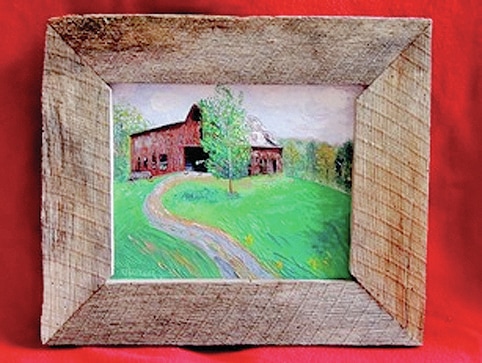
Editor’s Note – This is the fifth in a series of stories authored by Robert Kroeger, who has painted 11 barns in Highland County and has plans to paint more. The first 11 paintings, usually framed with actual wood from the barn pictured, will be auctioned off April 2 when the Highland County Extension Support Committee holds its annual dinner fundraiser at the fairgrounds. Proceeds from five of the paintings will benefit the committee. Kroeger titled this story “Easter’s Barn.”
When we drove up to this barn we could see its deteriorated state: gray boards exposed under fading red paint, missing sections, the metal roof warping. But the artist in me fell in love with it – the disarray, the black holes, reddish-gray siding, slopes and angles galore. The barn had character. It wanted to be painted, wanted to be remembered. I sensed the barn had a long and colorful history.
Sitting on top of a small knob, the ground led directly into the barn’s entrance, not requiring any dirt to build a bank as most old barns needed. Whoever built it chose a good spot. And no one knows who that person was or when it was. Judging from its construction – giant hand-hewn oak beams, mortise and tenon joints, and some beams cut only half through the log – made me think it might have been built before the Civil War, though that’s debatable.
Scott and Andrea Anderson recently purchased it from Chris and Leigh Ann Easter, whose family owned it for many years. Scott told me that it would be taken down – too dangerous for his children. Children love to explore and play in an old barn. What child doesn’t?
The Easter family goes back a long way. Grandpa Easter lived to 99. They bought the farm from Elmer and Elsie Jordan and used it to house cattle, though the Jordans used it for dairy cows. Before the Jordans, a couple named Oscar and Pearl Parshall owned it and lived in the farmhouse. Oscar also lived a long life, reaching 100 a few years ago when he died. There must be something special in Highland County water.
The original owner was a clever fellow, building the farmhouse over a natural spring, which he used to provide water and keep produce cool. Although there’s no hard proof, former owners heard that a book mentioned the house as a hiding place for slaves on the Underground Railroad, which would date it prior to the Civil War. A room in the basement with a dirt floor was where the slaves reportedly hid.
Further up a hill from the farmhouse is a small, rugged building, a little schoolhouse that has also been preserved. In the old days it used to sit across the street, making a short commute for any children who lived in the house.
These days a forest of trees has overtaken the fields where the cows grazed. Maples, elms, and oaks now stand where pastures covered the hills. The cows and cattle are gone, but the Easters’ barn won’t be forgotten.
For more information visit www.barnart.weebly.com.
Robert Kroeger is a former Cincinnati area dentist who has since ran in and organized marathons, took up the painting skills he first picked up from his commercial artist father, become a published author, and is a certified personal trainer that started the LifeNuts vitality program.


